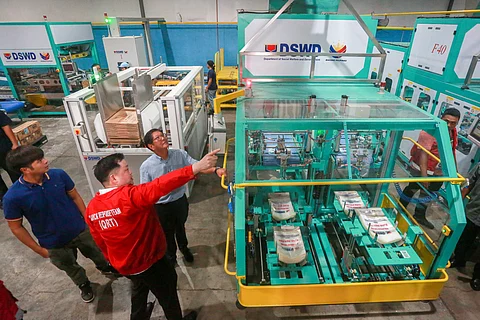
- NEWS
- the EDIT
- COMMENTARY
- BUSINESS
- LIFE
- SHOW
- ACTION
- GLOBAL GOALS
- SNAPS
- DYARYO TIRADA
- MORE

President Ferdinand R. Marcos Jr. on Friday lauded the Department of Social Welfare and Development for the mechanized production of food packs which has speeded up the distribution of relief goods.
The President expressed his satisfaction during a visit to the National Resource Operations Center (NROC) in Pasay City where he inspected the new mechanized production system.
The President was accompanied by DSWD Secretary Rex Gatchalian and his son, William Vincent, during his inspection of the new packing system at the agency’s main disaster response hub. The system includes a three-rice vacuum seal application and barcoding for efficient monitoring of family food packs (FFP).
“It was President Marcos who ordered the speedy production of family food packs and the DSWD obliged,” Secretary Gatchalian told reporters while waiting for the President to arrive at the NROC.
The DSWD has been continuously improving its disaster response capabilities as part of the Buong Bansa Handa (BBH) Program which is based on the directive of President Marcos Jr. to ensure a fail-safe mechanism in the country’s supply chains during calamities.
The BBH employs two parallel supply chain mechanisms for disaster preparedness and response. The first one features a national and local government-driven supply chain, while the second supply chain forges partnerships with established large and small groceries, supermarkets, manufacturers, and distributors to leverage their technical expertise and resources and create a private sector-driven supply chain.
Ahead of Tropical Storm “Crising,” the DSWD had prepositioned three million FFPs across 934 storage hubs nationwide complemented by the continuous production of new relief supplies at the agency’s main warehouses, the NROC, and the Visayas Disaster Resource Center (VDRC) in Mandaue City, Cebu
The new mechanized packing system at NROC, combined with the new system in VDRC, is capable of producing 75,000 FFPs a day.
Gatchalian directed all DSWD’s Field Offices (FO) nationwide to make sure that disaster response personnel will be immediately deployed and relief goods will be swiftly distributed to areas in need of aid any time of the day.
The DSWD has P2.9-billion worth of standby funds and stockpiles comprising more than three million FFPs and at least 28,107 ready-to-eat food (RTEF) boxes and 334,791 non-food items (NFI).
On 11 July, the DSWD signed a Memorandum of Agreement with the Clark International Airport Corporation for the establishment of a Regional Disaster Response Command Center (RDRCC) and a warehouse facility at the Clark Civil Aviation Complex and the Industrial Estate 5.
Once set up, the RDRCC in Clark will be the newest addition to the agency’s main disaster response hubs, which include the NROC and the VDRC.
